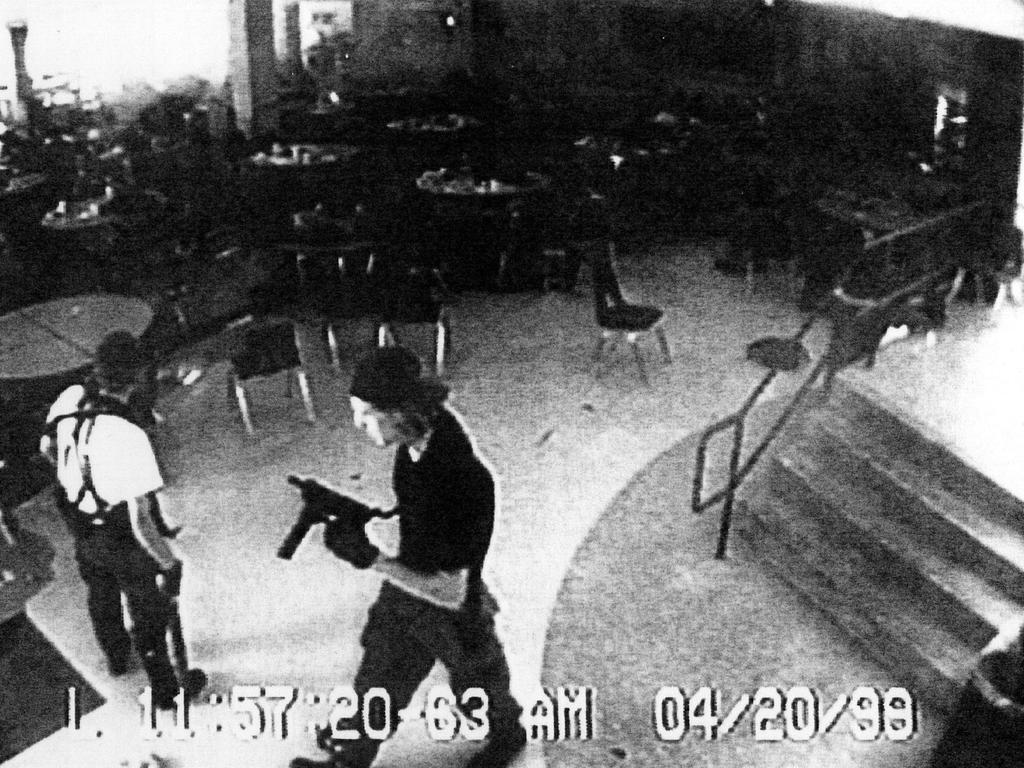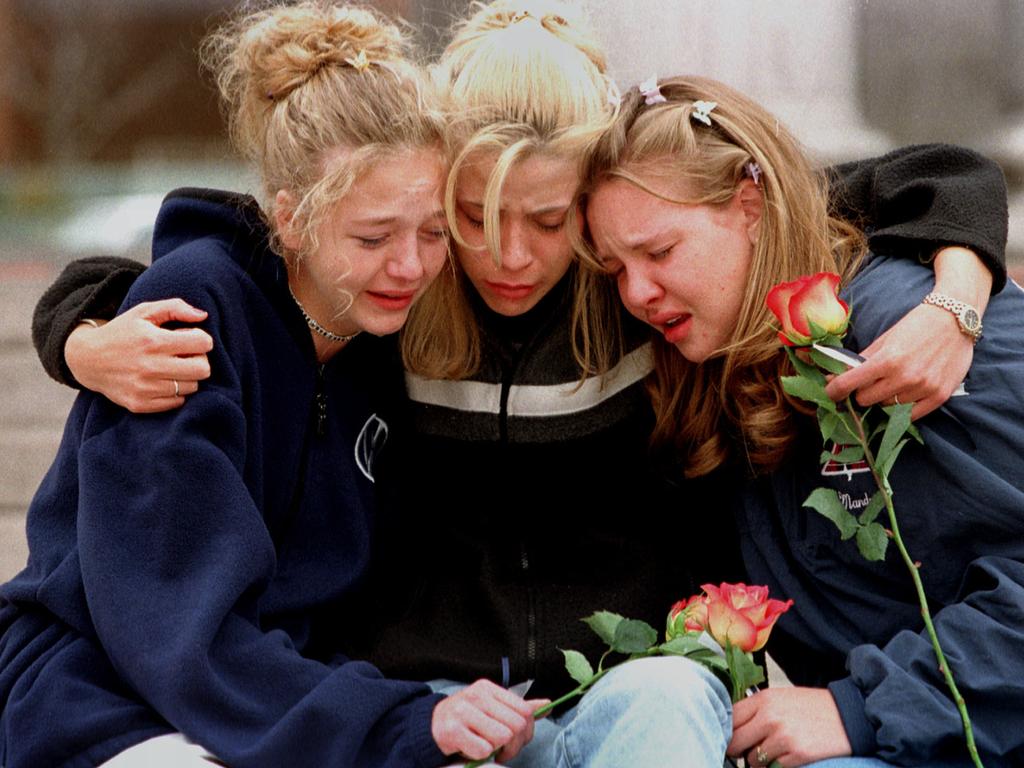Columbine’s chilling legacy: America’s insane plan to stop school shooters
Blu Gilliand’s twin daughters were nine years old when they came home and told him about the special lessons they’d been having at school.
When Blu Gilliand’s nine-year-old twin daughters came home from school three years ago and told him they had learned how to defend themselves against a school shooter that day, he was shocked.
“They learned to identify parts of the classroom that are not visible from windows or doors to hide in,” says the 48-year-old father from Wetumpka, Alabama.
“Then, if an intruder makes it inside, they learned how to throw books and chairs at the person to try to run them off.”
Gilliand’s daughters, who are now 12 years old, receive ALICE training — Alert, Lockdown, Inform, Counter, Evacuate — in their classroom each year.
And they’re not alone, with training drills on what to do in the event of an active shooter now conducted in some 95 per cent of public schools in the United States.
ALICE training began in response to the Columbine High School massacre on April 20, 1999, where 12 pupils and one teacher were killed by fellow students.
This week marks the 20th anniversary of the attack, as well as 13 years since the Virginia Tech shooting, where 33 college students were gunned down on April 16, 2007.
It is estimated that over 220,000 children have been exposed to gun violence at school since Columbine.
RELATED: FBI hunt woman linked to threat that sparked Columbine High lockdown
RELATED: Columbine shooting-obsessed teenager dead
RELATED: Columbine High survivor says teachers should be armed

“Learning to deal with an active shooter should be taught on the first day of kindergarten,” says Greg Shaffer, a former FBI Hostage Rescue Team agent who is now head of risk management firm Shaffer Security Group, which trains schools and workplaces on what to do in an active shooter scenario.
Shaffer prefers the strategy of ‘avoid, deny, defend’ — and believes that people need to be trained in such a situation to replace fear with the confidence to act.
“We teach people to avoid a shooter if you can see him — if know where he is at, you run. If you can’t run, deny him access by locking the doors,” he says.
“Then, prepare to defend yourself using improvised weapons. There are five or six things I recommend every teacher have in their desk drawer: a hammer, a box cutter, a screwdriver, pepper spray, a CO2 fire extinguisher, and three cans of soup in a pillow case.”
Shaffer is adamant that teaching anyone, even small children, to take cover is dangerous.

Chris Dorn, an analyst with school safety group Safe Havens International, fears that the current climate has produced a psychological effect on teachers that makes them think they need to be heroes.
“There’s a big push to take a more aggressive response when there’s not really a lot of evidence to show that it’s a better response,” he says.
He says that “rogue operators” have become common in the training world, emerging in force after the Sandy Hook tragedy in 2012, where a gunman killed 20 children aged six and seven years old, and six members of staff.
“A narrative emerged that the principal had sacrificed herself to defend her school, but in reality, she happened to be in wrong place at the wrong time.
“Now, I hear school teachers and administrators saying, ‘I have to die for my students, so what do I do?’”
Dorn also believes that there is too much emphasis on the risk of school shootings compared to other risks of injury.
“Between 1998 and 2012, we did some research on types of deaths that happened on K-12 school campuses, and found that there were 62 active shooter deaths compared to 525 transportation related deaths — but we don’t seem to think traffic accidents are worth addressing.”

Still, he believes that teachers need to be trained to trust their judgment in an emergency — but in a way that doesn’t traumatise them.
“One insurer in Iowa paid out $400,000 in the first year for workers compensation claims in districts where they started having ALICE training,” he says.
“Some are so hands on that they’re dangerous, others are psychologically damaging. They get people focused on something that is very, very unlikely, to the point that we are seeing teachers too scared to go to school and leaving the profession.”
Andrew Patrick from the Coalition for Gun Control thinks that training for students and teachers is necessary in lieu of meaningful gun reform in country.
“Unfortunately, as long as we have weak gun laws — meaning people have access to weapons that can kill dozens in minutes — we are going to have to have training to help keep kids safe.”
Despite the fact that there were armed guards at both Columbine and Virginia Tech, politicians in the United States including President Trump have endorsed appointing armed guards rather than increasing the numbers of school counsellors or restricting the sale of guns.
A survey conducted by the National Center for Education Statistics showed that armed officers were present at least once a week in 43 per cent of America’s public schools, up from 31 per cent of schools a decade earlier.
“The move towards so-called secure schools is really a push by the gun lobby to sell more guns,” Patrick says. “Instead of having a Wild West firefight in our nation’s schools, we need to pass laws to reduce guns to prevent these tragedies.”

University of Alabama Criminology Professor Adam Lankford says that paying attention to warning signs is the first step to reducing school shootings.
“More than 80 per cent of school shooters told at least one person what they were planning. When people hear those kind of threats, they need to report them, and law enforcement has to do a better job of taking these reports seriously and investigating them.”
The FBI received two tip offs that the perpetrator of the 2018 shooting at Parkland High School in Florida that killed 17 people was a “school shooter in the making” — but neither tip was sent to local agents to investigate.
Blu Gilliand says that while he’s glad that his daughters are being prepared and their school has a plan in place in the event of a Parkland or Columbine, the fact that it is necessary is deeply troubling.
“It makes me incredibly sad that this is something they have to even think about. I want my girls to be aware and know what to do in an emergency. But to know that this is in the back of their mind when they walk into their classroom each day, that’s not right,” he says.
Coming from a rural background, Gilliand says he isn’t anti-gun, but firmly believes that there should be more stringent background checks and restrictions placed on the sale of semiautomatic weapons.
“It’s very simple, but my country can’t seem to wrap its head around it,” he says.
Elle Hardy is an Australian-born, US-based freelance writer. Continue the conversation @ellehardy



